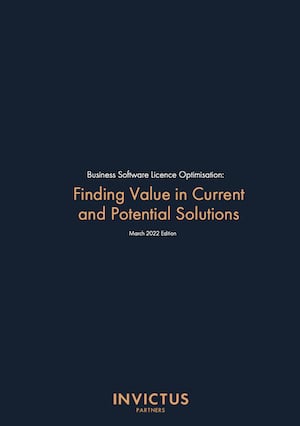Software Licence Management: 3 Tips for Avoiding an “Oh $#!?” Moment
Whether you’re running SAP, Oracle, Microsoft, IBM, other pure play applications, or a combination of the above, things can quickly get messy if you’re not proactively managing your enterprise software licences. This is particularly so if you’re transforming your business, such as replacing legacy applications, updating your infrastructure and/or migrating applications or workloads to the Cloud.
When you get your renewal bill and discover how much money the organisation is paying for software that is not being utilised (a.k.a. shelfware), it can definitely trigger a swearing moment, particularly if you find this out months or even years down the track. Think of all the cost savings that could have been realised, or the growth and innovation projects that could have been funded, had this knowledge come to light sooner.
On the flip side, if you’re inadvertently over-deployed / under-licensed this can most definitely result in the use of profanities. This may be due to a lack of visibility around changes that impact licence requirements, growth within your organisation, or even changes to vendor terms and conditions. It can be especially stressful when the vendor uncovers this non-compliance through an extended and time consuming audit and slaps a hefty fine on your organisation.
Here are our top 3 tips for taking the expletives out of managing your enterprise software licensing:
1) Do your own independent analysis
Don’t just accept what the software vendors, their resellers or LSP’s tell you. For example, 95% of Invictus Partners’ software licence audit reviews conducted for clients have led to reductions in licence spend with major vendors. Know your compliance position, using independent Software Asset Management (SAM) processes, tools and trusted advisors.
It is important to acknowledge that software licence optimisation is dynamic and ever-evolving. It is not sufficient to simply “set and forget” in the early stages of your software implementation. Changes over time, either within your organisation and/or on the vendor side can have a material impact on your enterprise software licence compliance. Having a clear understanding of your contractual obligations at any point in time is critical, particularly if there have been multiple contract amendments, changes to organisational structures, acquisitions, divestitures or implementation of new projects that may impact access and usage (for example Indirect Access in the case of integrations to the SAP core).
Software vendors may give advice, however recognise that they may also have a vested interest in selling more licences, support and services. If you don’t have the in-house resources or expertise to proactively track your ongoing licence compliance, there are a number of independent and objective SAM advisory organisations that can assist you. Be wary of organisations that may have a vested interest in the outcome, due to partnerships and commercial arrangements with specific software vendors and in particular, the organisations who are also approved vendor auditors.
2) Talk to a licensing expert BEFORE embarking on your digital transformation
Before you dive head first into your business and IT transformation, there are some key things to consider. As businesses increasingly transition to digital technology, licence footprints can easily grow in complexity. The result can either be over spend on software, or punitive fines from over deployment. It's a delicate balance between paying too much on your software, or being in a position of having to pay fines from over use of your software.
This is why it’s critical to get a thorough understanding of present and future software licence requirements, including budgetary and compliance implications. The waters can quickly get muddied when multiple new applications are being deployed and when direct and indirect access implications are not clearly understood.
Organisations that optimise their software costs before taking the plunge to embrace digital transformation often emerge as clear front runners in the race to evolve and grow their business. These organisations can move forward with the confidence that they are spending their money wisely and are usually more agile than their competitors. They have more clarity on what is needed to extract value from their investments and to move forward with the technological changes required in a digital world.
3) Don’t assume Cloud-based licence management is easier or cheaper
Before you embark on replacing an on-premise application with a SaaS solution, or migrating applications and workloads to the Cloud, it is a good idea to have a thorough understanding of the implications of such a shift. A move to cloud can trigger compliance clauses and additional costs can rapidly accrue.
Whilst on the surface SaaS solutions appear to be lower cost and easier to consume and manage, there are numerous factors (e.g. user numbers and module functionality) that will impact the actual cost of running these solutions. Business cases are not always achieved. It pays to understand your business requirements and how you will need to consume the solution to match them.
As organisations look to leverage Cloud infrastructure offerings for existing workloads and business applications (primarily to reduce Data Centre footprints and costs), the reality of a perceived “lift and shift” is far more complex and risky. Many on-premise software licence agreements do not cover Cloud usage, nor can they be transferred to the Cloud. The level of licence portability to the Cloud can even differ across a vendor’s products. Given this complexity, it’s really important to do your due diligence on a product-by-product basis.
Cloud infrastructure consumption-based cost models often displayed as fractions of cents, can lure the unprepared into thinking that significant savings are coming their way. The reality is that these costs quickly add up and often run into higher dollars than on-premise Data Centres. Detailed understanding of compute usage and operational best practices are essential to a successful migration. If done right, a shift to the Cloud provides the opportunity for organisations to reassess and optimise licence requirements.


